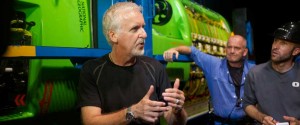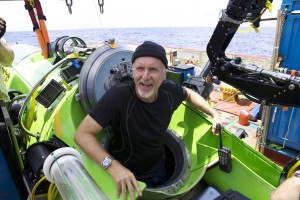![]()

The system is immediately being put to work on James Cameron’s Deepsea Challenge documentary, which is currently in postproduction at Digital Pictures in Melbourne.
The documentary depicts how Cameron, Academy award-winning director of Titanic and Avatar, plunged to the deepest known point in the world’s oceans, a 2,400-km-long trench located 11 km below the surface of the Pacific Ocean called the Mariana Trench. The film is a journey that took place in a purpose-built, one-man submersible named “Deepsea Challenger.” To document the journey, the submersible was equipped with multiple stereoscopic 3D camera systems recording to a variety of digital file formats. Cameron successfully completed the dive March 26, making history as the first person to reach full ocean depth in a solo-manned vehicle, spending up to three hours on the sea floor and documenting his experience in stereoscopic 3D.
The sub had to protect the pilot from the extreme water pressure at 11 Km below the surface. The pilot was housed in a chamber measuring only 106cm across internally, so by the time they squeezed in the pilot plus all the navigation and safety systems required, there was scarcely space left for full-sized stereo 3D camera rigs. Despite the lack of space, one miniature 3D rig using custom-built cameras recorded the pilot’s activities at all times. In addition to this, another set of custom 3D cameras were mounted outside the submersible on a robotic boom arm in their own pressure-proof chamber, used to record any strange life-forms or dramatic geology.

Camera crews followed the Deepsea Challenge team from the start of the project, recording over a thousand hours of behind-the-scenes footage including design meetings, construction of the submersible, dive testing as well as the expedition and main dive itself. In all, Digital Pictures is storing approximately 220TB of stereoscopic footage on its robotically controlled DAM system. A total of 10 different types of cameras were used throughout the project, recording to a mix of R3D, mp4, mov, siv and other video file formats at resolutions ranging from HD to 5K.
Mistika’s ability to work natively with all these camera files, in any mix of resolutions on the same timeline in real time stereo meant that there was no need to transcode footage to another format before use. This helps prevent the amount of data from ballooning unnecessarily, as well as saving transcoding time during post.
Various 2D and 3D deliverables have been specified, including a 3D IMAX version of the film, all of which are being posted at Digital Pictures.
“Australia will always be seen as a platform for prominent creative talent in the film and television industry,” said Digital Pictures general manager Sarah Cloutier. “By introducing a flexible, world-leading system such as Mistika to our workflow makes great investment sense. Mistika will enable us to maintain our position as a leading technical and creative film-making collaborator.”





